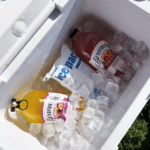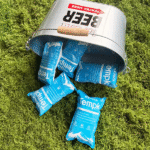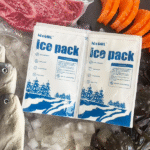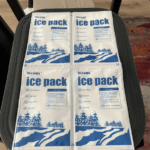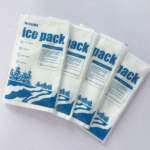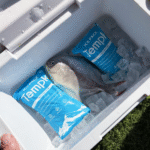Mantener fríos tus productos perecederos sin dañar el planeta ya no es una opción, es una necesidad. Paquetes de hielo seco ecológicos Ofrecer una solución que ofrece temperaturas bajas constantes y al mismo tiempo reduce los residuos y las emisiones de carbono.. El mercado actual de logística de cadena de frío vale alrededor $78 mil millones en los EE.UU.., sin embargo, casi la mitad de los consumidores juzgan las marcas por el impacto medioambiental de sus envases.. Cambiando a tecnologías de refrigeración sostenibles, puedes proteger los bienes y el planeta. Esta guía explica cómo funcionan las bolsas de hielo seco ecológicas., Por qué importan, y cómo elegir la opción adecuada para tus envíos.
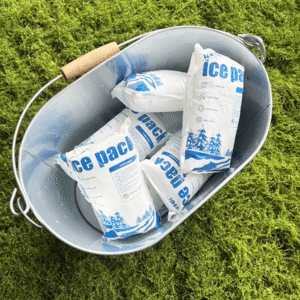
¿Qué hace que las bolsas de hielo seco ecológicas sean mejores?? Descubra cómo estos paquetes reducen los residuos plásticos, Reduce la huella de carbono y dura más que las bolsas de hielo tradicionales..
¿Cómo funcionan los materiales de refrigeración sostenibles?? Descubra el papel de los materiales de cambio de fase, Capas aislantes y carcasas reutilizables para mantener temperaturas seguras..
¿Qué industrias se benefician más?? Vea por qué farmacéutica, Los sectores alimentario y biotecnológico están adoptando opciones ecológicas..
¿Cómo se selecciona el paquete adecuado para diferentes envíos?? Comparar paquetes de gel, esteras PCM, paneles aislados al vacío y aislamiento de lana para diferentes distancias y tipos de productos.
¿Cuáles son las últimas tendencias e innovaciones en 2025? Explora los recubrimientos biodegradables, sensores inteligentes, captura de carbono y otros avances que dan forma al futuro.
¿Qué son las bolsas de hielo seco ecológicas y por qué deberías cambiarlas??
Las bolsas de hielo seco ecológicas son sistemas de refrigeración diseñados para mantener temperaturas ultrabajas y minimizar el impacto medioambiental.. A diferencia de las tradicionales bolsas de gel o hielo desechable, estos paquetes aprovechan dióxido de carbono sólido (hielo seco) o materiales de cambio de fase (PCM) para mantener los productos congelados o refrigerados sin dejar residuos acuosos. El hielo seco se sublima directamente de sólido a gas a aproximadamente –109,3 °F (–78,5 ºC), proporcionando estable, Condiciones ultra frías necesarias para envíos sensibles.. porque sublima, no hay agua de deshielo líquida que pueda dañar los envases o los productos. Aún mejor, El hielo seco a menudo se produce a partir de CO₂ reciclado capturado en procesos industriales., convertir el gas residual en un refrigerante útil.
Por qué son mejores que las opciones tradicionales
Reducción de residuos plásticos: Los paquetes de gel tradicionales requieren carcasas de plástico que a menudo terminan en vertederos. El hielo seco elimina esa necesidad y se basa en productos reutilizables., contenedores aislados.
Menor huella de carbono: El hielo seco es un subproducto de industrias como la producción de amoníaco y etanol., lo que significa que su uso reutiliza el CO₂ existente en lugar de generar nuevas emisiones..
Consumo mínimo de agua: La producción de bolsas de hielo o gel consume una cantidad considerable de agua.. El hielo seco se crea sin agua, conservando recursos.
Reciclable y biodegradable: Porque el hielo seco se sublima por completo, No hay residuos sólidos que eliminar, lo que lo convierte en un producto natural., refrigerante biodegradable.
Uso a largo plazo: Muchos envases ecológicos están diseñados para su reutilización, permitiendo a las empresas reducir costos y desperdicios con el tiempo.
Estas ventajas hacen que las bolsas de hielo seco ecológicas sean una opción inteligente para las empresas que enfrentan presión para reducir su huella ambiental y al mismo tiempo ofrecer productos seguros., productos de alta calidad.
Componentes clave y cómo funcionan
Las bolsas de hielo seco ecológicas suelen constar de tres componentes principales:
| Componente | Descripción | Significado |
| Capa de aislamiento | Fabricado con materiales como espuma de alta densidad., Revestimientos a base de papel o paneles aislados al vacío. (VIP); Reduce la transferencia de calor entre el ambiente externo y los productos embalados.. | Prolonga el efecto de enfriamiento y reduce la cantidad de refrigerantes necesarios., ahorrando espacio y costo. |
| Núcleo de cambio de fase | Contiene gránulos de hielo seco o un material de cambio de fase diseñado para derretirse o solidificarse a temperaturas específicas.. Los PCM mantienen temperaturas de entre 2 y 8 °C o –20 °C, mientras que el hielo seco permanece por debajo de –70 °C. | Proporciona temperaturas estables para productos como vacunas., biológicos, mariscos o carnes; ayuda a evitar picos de temperatura que provocan deterioro. |
| Carcasa exterior protectora | Carcasa duradera y reutilizable fabricada con materiales como polietileno o papel reciclado.. Proporciona protección física y ayuda a contener la compresa fría.. | Mejora la seguridad y permite múltiples usos., Reducir el desperdicio y el costo general.. |
Consejos prácticos para utilizar bolsas de hielo seco ecológicas
Capa correctamente: Rodee los productos con refrigerante pero evite el contacto directo con artículos sensibles para evitar daños por congelación..
Ventilar: El hielo seco se sublima en gas dióxido de carbono; Empacar los envíos en contenedores que permitan que el gas escape para evitar la acumulación de presión..
Monitorear temperaturas: Utilice sensores inteligentes o etiquetas sensibles a la temperatura para garantizar que los envíos permanezcan dentro del rango requerido.
Combinaciones híbridas: Para envíos que necesitan temperaturas frías pero no heladas, combine hielo seco con paquetes de gel o PCM para lograr el rango de temperatura ideal.
Aplicaciones industriales: ¿Quién se beneficia más??
Las bolsas de hielo seco ecológicas son esenciales en múltiples sectores:
Farmacéutica y Biotecnología: Vacunas, La insulina y los productos biológicos requieren un estricto control de la temperatura.. El envasado sostenible con hielo seco proporciona condiciones ultrafrías sin humedad, Garantizar la eficacia de los medicamentos y el cumplimiento normativo..
Alimentos y Bebidas: Desde kits de comida por suscripción hasta mariscos y lácteos, Estos paquetes mantienen los alimentos frescos y reducen el deterioro.. La refrigeración con bajas emisiones de carbono atrae a los consumidores que se preocupan cada vez más por la sostenibilidad de los envases.
Ensayos clínicos y productos biológicos: Muestras de investigación, Los componentes CRISPR y los productos sanguíneos deben permanecer congelados; Los sistemas de hielo seco ultrafrío o PCM garantizan la integridad de la muestra.
Comercio electrónico y kits de comidas: El rápido crecimiento del envío directo al consumidor de productos perecederos requiere una refrigeración confiable con un desperdicio mínimo. Los envases reutilizables apoyan los modelos de logística circular.
Ejemplo del mundo real
Una empresa de logística farmacéutica cambió a bolsas de hielo seco reutilizables e informó de un 20 % reducción de los costes de refrigeración después de seis meses, junto con una importante reducción de residuos. Esto demuestra cómo los envases ecológicos pueden reducir simultáneamente los gastos operativos y respaldar los objetivos medioambientales..
Beneficios de impacto ambiental y sostenibilidad
Por qué es importante la sostenibilidad
La logística de la cadena de frío depende de grandes cantidades de materiales de embalaje y refrigerantes, muchos de los cuales terminan como residuos. En 2018 Estados Unidos. generado 80,000 toneladas de poliestireno expandido (EPS) embalaje de espuma, todavía menos que 1 % fue reciclado. Los paquetes de gel tradicionales contienen geles a base de petróleo y revestimientos de plástico que permanecen en los vertederos.. La presión regulatoria y de los consumidores está aumentando: 43 % de consumidores Considere la sostenibilidad del embalaje al tomar decisiones de compra., y muchos países y EE.UU.. Los estados están restringiendo el uso de EPS..
Las bolsas de hielo seco respetuosas con el medio ambiente abordan estos problemas mediante varias ventajas medioambientales:
CO₂ reutilizado: El hielo seco se produce a partir del subproducto industrial CO₂., Reducir los residuos y apoyar la economía circular..
Sin revestimientos de plástico: Porque el hielo seco se sublima, no necesita bolsas de plástico. Los paquetes CelluLiner basados en papel protegen productos hasta 72 horas enfriado y refrigerado y 48 horas congeladas, eliminando los residuos plásticos.
Paquetes de gel aptos para drenaje: Innovaciones como los paquetes amigables con el drenaje de IPC utilizan gel no tóxico y carcasas reciclables en la acera para que los destinatarios puedan enjuagarlos y reciclarlos.. Estos envases ayudan a mantener el plástico fuera de los vertederos.
Opciones reutilizables y biodegradables: El Ice Cold Pack se puede reutilizar cientos de veces y contiene productos biodegradables., geles no toxicos, reducir drásticamente el número de envases de un solo uso desechados.
Menor consumo de agua: La producción de hielo seco consume menos agua que la congelación de bolsas de hielo convencionales..
Emisiones de carbono reducidas: El uso de energía renovable y tecnologías de producción bajo demanda puede reducir la huella de carbono de la fabricación de hielo seco.. Las tecnologías de captura y reutilización de carbono atrapan las emisiones de CO₂ y las convierten en hielo seco, reducir aún más las emisiones netas.
Comparando opciones de refrigeración
| Solución de enfriamiento | Impacto ambiental | Características clave | Mejores casos de uso |
| Paquete de gel tradicional | Envases de plástico de un solo uso., geles a base de petróleo; difícil de reciclar. | Mantiene el contenido debajo 40 ° F para hasta 48 horas pero puede tener fugas y requiere más aislamiento. | Corta distancia, envíos refrigerados; cajas de productos frescos y CSA. |
| Paquete de hielo seco (convencional) | Reutiliza CO₂ por producto, sin envases de plástico; sin embargo, todavía requiere pellets de una sola vez y genera gas CO₂. | Proporciona temperaturas ultra frías. (<–70°C); requiere manejo de materiales peligrosos y contenedores ventilados. | Mariscos congelados, biológicos, envíos ultracongelados. |
| Paquete de hielo seco ecológico (reutilizable) | Incluye aislamiento, cáscara reutilizable y hielo seco o PCM; Reduce los residuos de plástico y se puede utilizar varias veces.. | Mantiene el frío por más tiempo, reduce los residuos y los costes; puede integrar sensores inteligentes para monitoreo en tiempo real. | Productos farmacéuticos, envíos de alimentos de comercio electrónico, muestras de investigación. |
| Material de cambio de fase (PCM) | Reutilizable, Embalaje no peligroso con menos emisiones de CO₂.; mayor costo inicial. | Mantiene rangos de temperatura específicos (2–8 °C o –20 °C) y se puede reutilizar varias veces. | Vacunas, biológicos, Envíos de rango medio donde las temperaturas estables son cruciales.. |
| Aislamiento de lana con paquetes de gel. | Biodegradables y compostables; reduce los residuos de plástico. | Mantiene los envíos frescos durante uno o dos días.; ideal para entregas regionales. | Granjas y productores realizan envíos locales a clientes conscientes del medio ambiente. |
Como muestra la tabla, Opciones sostenibles como bolsas de hielo seco reutilizables., Los PCM y los revestimientos de lana natural brindan un sólido rendimiento térmico al tiempo que reducen drásticamente los desechos plásticos y las emisiones de carbono..
Consideraciones regulatorias y de seguridad
Las bolsas de hielo seco ecológicas deben manipularse de forma responsable. El hielo seco se sublima en gas CO₂ y puede desplazar el oxígeno en espacios confinados, Por lo tanto, asegúrese de que los contenedores estén ventilados y que el personal utilice el equipo de protección adecuado.. Si el envío es por aire, seguir las pautas de materiales peligrosos y los requisitos de etiquetado. Es esencial capacitar al personal en manipulación segura y cumplimiento normativo..
Elegir la solución de refrigeración ecológica adecuada
Seleccionar la bolsa de hielo seco ecológica adecuada depende de varios factores:
1. Requisitos de temperatura de envío
Cocina refrigerada (2–8 ° C): Los paquetes PCM diseñados para esta gama proporcionan temperaturas constantes y son reutilizables. Los paquetes de gel también pueden mantener temperaturas por debajo 40 ° F para hasta 48 horas.
Gama congelada (–20 ºC): Los paquetes PCM clasificados para –20 °C o los paquetes sustitutos de hielo seco ofrecen temperaturas de congelación profunda sin humedad. Estos son aptos para helado., carnes y ciertos productos farmacéuticos.
ultra frio (por debajo de –70 °C): Todavía se requiere hielo seco convencional para envíos como kits CRISPR o células congeladas..
2. Duración del tránsito
Corta distancia (bajo 48 horas): Las compresas de gel o las mantas de agua helada funcionan bien durante uno o dos días.. El aislamiento de lana con paquetes de gel ofrece una opción ecológica para envíos regionales.
rango medio (2–5 días): Los paquetes PCM o paquetes de gel aptos para drenaje combinados con revestimientos reciclables mantienen temperaturas estables para envíos de rango medio.
De larga distancia (5–10 días): Paneles aislados al vacío (VIP) combinado con compresas frías mantiene los productos congelados durante siete a diez días, haciéndolos ideales para entregas a través del país o envíos vulnerables a retrasos.
3. Complejidad regulatoria
Si quieres evitar el etiquetado de materiales peligrosos y simplificar los trámites aduaneros, opte por paquetes con aislamiento de lana o PCM. El hielo seco requiere el cumplimiento de las regulaciones IATA y DOT y puede no ser adecuado para envíos internacionales.. Al usar hielo seco, Asegúrese de que el embalaje cumpla con los estándares de seguridad e incluya ventilación adecuada..
4. Objetivos presupuestarios y de sostenibilidad
Si bien los sistemas PCM tienen costos iniciales más altos, Se pueden reutilizar varias veces y reducir los gastos a largo plazo.. El hielo seco es económico por envío, pero genera costos recurrentes y preocupaciones sobre su eliminación.. Considere el impacto ambiental: Los revestimientos de lana y CelluLiner a base de papel reciclable reducen los residuos de plástico y se alinean con los compromisos de sostenibilidad..
2025 Tendencias e innovaciones en envases sostenibles para la cadena de frío
La industria de la cadena de frío está evolucionando rápidamente. Estas son las tendencias clave que están dando forma 2025 y más allá:
Recubrimientos biodegradables: Los fabricantes están experimentando con recubrimientos para bolsas de hielo seco que se descomponen naturalmente después de su uso., reduciendo aún más el desperdicio.
Sensores inteligentes e integración de IoT: El monitoreo de temperatura en tiempo real mediante sensores integrados en los paquetes permite a los operadores rastrear los envíos e intervenir antes de que se echen a perder..
Materiales de cambio de fase con rangos de temperatura más amplios.: Se pueden diseñar nuevos PCM para apuntar a rangos de temperatura específicos, mejorando la flexibilidad y reduciendo la necesidad de hielo seco.
Paneles aislados al vacío: Los VIP reducen la transferencia de calor, Permitir a los transportistas utilizar menos refrigerantes y extender la duración del enfriamiento a 7 a 10 días..
Captura y reutilización de carbono: Los sistemas avanzados de captura de carbono atrapan las emisiones de CO₂ de las plantas industriales y las reutilizan para producir hielo seco., reducir las emisiones netas de gases de efecto invernadero.
Producción de energía renovable: Los fabricantes de hielo seco están integrando la energía solar y eólica en sus operaciones, Reducir el consumo de energía y la huella de carbono..
Sistemas de producción bajo demanda: Las máquinas compactas permiten a las empresas producir hielo seco en el sitio y según sea necesario, reducir las emisiones y los residuos del transporte.
Estas innovaciones resaltan cómo la tecnología y la sostenibilidad están convergiendo para crear una cadena de frío más responsable..
Perspectivas del mercado y demanda de los consumidores.
El mercado de la logística de la cadena de frío está creciendo rápidamente y está valorado en aproximadamente $78 mil millones en los estados unidos.
43 % de consumidores Considere el impacto ambiental del embalaje al realizar una compra.. Este cambio está impulsando a las empresas a adoptar soluciones de cadena de frío reciclables y reutilizables..
74 % de americanos están interesados en comprar productos en envases recargables, Señalando una fuerte demanda de logística sostenible..
Restricciones al poliestireno expandido (EPS) la espuma se está extendiendo: más que 30 países y varios EE.UU.. los estados han promulgado limitaciones, Lo que llevó a las empresas a buscar alternativas como CelluLiner a base de papel y refrigeradores biodegradables..
Preguntas frecuentes
Q1: ¿Cuánto tiempo mantienen fríos los productos las bolsas de hielo seco ecológicas??
Las bolsas de hielo seco reutilizables suelen mantener condiciones ultrafrías durante 12 a 24 horas, aunque la duración real depende de la temperatura exterior y la cantidad de hielo seco. Los paneles aislados al vacío pueden extender las condiciones de congelación a siete a diez días.
Q2: ¿Las bolsas de hielo seco ecológicas son seguras para alimentos y productos farmacéuticos??
Sí. Porque el hielo seco se sublima directamente en gas dióxido de carbono., no hay agua líquida que contamine los envases. Los PCM y los geles no tóxicos utilizados en paquetes sostenibles son seguros para los alimentos y cumplen con los estándares regulatorios para envíos farmacéuticos..
Q3: ¿Qué hace que una bolsa de hielo seco sea “ecológica”??
Un paquete ecológico utiliza materiales que se pueden reutilizar o reciclar., contiene contenidos no tóxicos, y reduce los residuos o las emisiones de carbono.. Los ejemplos incluyen carcasas reutilizables con PCM., forros de lana biodegradables, y paquetes de gel aptos para drenaje.
Q4: ¿Puedo desechar las bolsas de hielo seco en la basura normal??
Deje que el hielo seco restante se sublime en un área bien ventilada.. Luego recicle o reutilice el caparazón si es posible.. Los paquetes de gel aptos para drenaje se pueden vaciar en el fregadero y reciclar la carcasa de plástico.. Nunca coloque hielo seco en un contenedor de basura sellado, ya que la acumulación de presión podría causar daños.
Q5: ¿Son los materiales de cambio de fase mejores que el hielo seco??
Los PCM mantienen rangos de temperatura específicos y no son peligrosos.. Son ideales para envíos entre 2 y 8 °C o –20 °C y se pueden reutilizar varias veces.. Sin embargo, no pueden alcanzar las temperaturas ultrafrías requeridas para ciertas muestras biológicas, donde el hielo seco aún destaca. Un enfoque híbrido suele proporcionar el mejor equilibrio entre sostenibilidad y rendimiento..
Resumen y recomendaciones
La logística sostenible de la cadena de frío ya no es una preocupación de nicho: es un imperativo empresarial. Las bolsas de hielo seco respetuosas con el medio ambiente ofrecen una forma eficaz de reducir el impacto medioambiental manteniendo al mismo tiempo un control de temperatura fiable. Las conclusiones clave incluyen:
Reducir los residuos y las emisiones: Paquetes de hielo secos reutilizables, Los revestimientos a base de papel y los geles aptos para drenaje reducen drásticamente los residuos plásticos y la huella de carbono..
Control de temperatura superior: El hielo seco y los materiales de cambio de fase proporcionan estabilidad., condiciones ultra frías sin daños por agua.
Beneficios económicos: Las empresas pueden reducir los costos operativos mediante la reutilización y la reducción del deterioro..
Innovaciones en evolución: Recubrimientos biodegradables, Los sensores inteligentes y la producción de energía renovable están haciendo que los envases de la cadena de frío sean aún más ecológicos..
Próximos pasos viables
Evalúe sus perfiles de envío: Determine los rangos de temperatura y las duraciones típicas de sus productos y elija envases ecológicos en consecuencia.
Opciones piloto sostenibles: Pruebe paquetes de hielo seco reutilizables o PCM a pequeña escala para medir el rendimiento y el ahorro de costos..
Educa a tu equipo: Capacite al personal sobre el manejo del hielo seco y los requisitos de cumplimiento..
Comunique sus esfuerzos de sostenibilidad: Los consumidores aprecian las marcas que priorizan el medio ambiente. Comparta sus prácticas ecológicas en embalajes y materiales de marketing..
Consultar expertos: Asóciese con proveedores como Tempk para evaluar las mejores soluciones para su negocio.
Acerca de Tempk
Y tempk, Nos especializamos en paquetes de hielo seco ecológicos y soluciones personalizadas de cadena de frío.. Nuestras mochilas reutilizables combinan aislamiento de alto rendimiento con materiales sostenibles, garantizar que sus envíos permanezcan seguros y frescos. Con décadas de experiencia en logística de cadena de frío y enfoque en la innovación., Ayudamos a las empresas a reducir costos e impacto ambiental.. Contáctenos para saber cómo podemos personalizar una solución que satisfaga sus necesidades específicas y respalde sus objetivos de sostenibilidad..
















